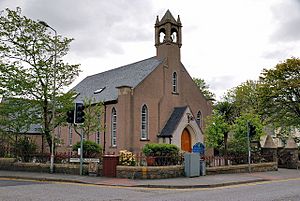Stornoway High Church facts for kids
Quick facts for kids The High Church of Stornoway |
|
|---|---|

High Church
|
|
| 58°12′40″N 6°22′56″W / 58.2110°N 6.3821°W | |
| Location | Stornoway, Scotland |
| Country | United Kingdom |
| Language(s) | English, Gaelic |
| Denomination | Church of Scotland |
| Previous denomination | United Free Church of Scotland |
| Tradition | Evangelical |
| Membership | 89 |
| Website | Church Website |
| History | |
| Former name(s) | United High Free Church of Scotland |
| Status | In congregation |
| Founded | 1902 |
| Founder(s) | The Reverend D. MacGregor |
| Architecture | |
| Functional status | Church |
| Style | Victorian Gothic |
| Completed | 1909 |
| Administration | |
| Presbytery | Lewis |
The Stornoway High Church is a church in Stornoway, Scotland. It belongs to the Church of Scotland. The church celebrated its 100th birthday in 2009. People worship here in both English and Gaelic. The English services are in the main church building. The Gaelic services are held in the 'New Hall'.
A Look at the Church's History
The church's story began with two older church groups. These groups joined together in October 1900. They formed a new group called the United Free Church of Scotland. At first, this new group did not have its own building.
A new church building was planned. On August 1, 1909, the church moved into its new home. It is located at the corner of Matheson Road and Goathill Road in Stornoway. In 1929, the United Free Church joined with the main Church of Scotland. This is when it became known as the Stornoway High Church of Scotland.
In 2019, Reverend Gordon MacLeod became the church's minister. At the end of 2022, the church had 82 members. By the end of 2023, this number grew to 89 members.
Worship Services and Meetings
The church holds worship services every Sunday. These services happen at 11:00 AM and 6:30 PM. The church also has meetings on Wednesday evenings at 7:30 PM.
Changes in 2013
On June 18, 2013, about 250 members of the church had a meeting. They voted to leave the Church of Scotland. This was because they had different ideas about some church rules. Those who left later joined the Free Church of Scotland. They started a new church group called the Stornoway High Free Church.

